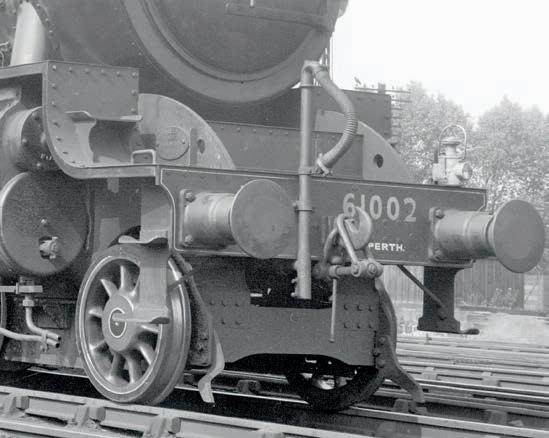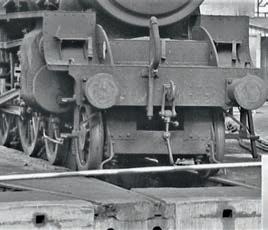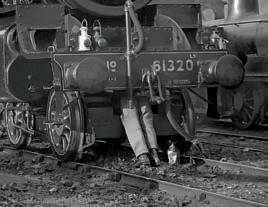
5 minute read
L N E R B 1 L o c o m o t i v e
Doug Hewson presents an authentic 5 inch gauge version of Thompson’s B1 locomotive.
We now come to the bogie frame drawings (fgs 55 to 59) so not many photographs this time I am afraid I have managed to find one photograph which I could blow up enough to give a half decent view of the guard irons Photograph 109 is actually of a green B1 photographed at Per th and I was ver y pleased to see it has the proper front bogie on it! It is the type fitted to the ones I have drawn as being from 8301 to 8310 until withdrawal. It is folded at either end to b olt it to the side frames, and it has the double scallop at the top and bottom That was all the information I could find but I got this information from an ‘Isinglass’ drawing I must say that these LNER locomotive drawings are absolutely full of information and I bought the one which was printed out at 13 5mm to a foot so that is half si e for five-inch gauge so it was a ver y long drawing! Anyway, I have included an enormous amount of detail from these drawings Photograph 110 is just a p hotograph taken around the turntable at Gilling East which shows a lovely B1 Klipspringer, which was laboriously rebuilt from a very old Martin Evans B1 by Brian Apthorpe, and it does now look very much like a B1 Alongside it is Peter Layfield’s and it looks as though it has just returned to the shed having been on a ‘Class F Through Goods Train’ judging by the head lamp code and just visible behind that is Tim Coles’s GT3. This provides a nice view of the guard irons on Brian’s B1


Photograph 111 - now, if you need any fire irons there is a very nice selection in this picture! It is 61037 surrounded by fire irons and just visible in the bottom of the picture is a lifting bar and there are several clinker shovels round about Leaning against the lamp post is a baffle plate, along with a couple lying on the ground and all manner of other items If your boiler has been built properly it should have a half round plate in the bottom of the fire hole ring which is shown on my drawing 10 in the full set The baffle plate sits on the top of the half ring inside the fire box Photograph 112 was photographed on 61153 in Canklow Roundhouse and shows a different type of bogie This one is the final type of bogie as shown on my drawing It is the fifth type as shown on the drawing I just had to show this photo (photo 113) which is of the bogie on 6 0 and shows the fourth type of bogie It would just be very nice to know who these legs belong to but it looks very much he is topping up the oil boxes on the front axle boxes


Now, I didn’t want you to be short of a job for a couple of weeks so if you have not made the screw couplings and buffers for your B1, yet I thought that I would just pop the drawings in for you to be getting on with (fgs 60 and 61) You can buy the buffer stocks and the draw hooks from The Steam Workshop I am not sure whether or now Geoff also has them in stock at G & S Supplies but it is always worth a try
Note that when making the buffers the spring retaining plate is the same size as the flange on the buffer stock and is held on with four 10BA countersunk screws The spring will just need to compress a little so that it can’t rattle about in its housing Believe me, that you should not be able the press the buffer in with finger pressure The springs need to be ¼ inches long by inch diamete r and be made from 6swg wire If you are buffing up to a train, I can assure you that they will compress!
I have shown on one of the drawings a nice little mudguard (fg 62) and these can be flanged over a former the way I made mine for my BR -6-4 Tank These were of course made in one piece I have actually shown small angles to attach them to the frame plates!
I made the patterns for the screw coupling shackles which I always used to buy in stainless steel, being easier to cast than mild steel, and you should also be able to buy those from one of the above named suppliers You will require a pair of gedge draw hooks, one pair of short shackles with a gedge in those and one pair of long shackles without the gedges in them
I d o n ’ t k n o w w h e t h e r a n y o n e i s g o i n g t o m a k e p a t t e r n s f o r t h e b o g i e a x l e b o x e s ( f g 6 3 ) b u t i t w o u l d b e v e r y n i c e i f t h e y d i d - y o u w i l l n e e d t w o o f o n e h a n d a n d t w o o p p o s i t e h a n d o n e s S o m e o n e n e e d s t o m a k e a 3 D d r a w i n g o f t h e m a n d w e c a n d o t h e r e s t T h e
Buffer heads and stocks
Mudguard Over Rear Wheel Of Bogie
Mat’l: Mild steel, LH shown
Bogie mudguard d r a w i n g n e e d s a 4 % s h r i n k a g e a l l o w a n c e o n t h e m i f a n y o n e f a n c i e s h a v i n g a g o a t t h a t T h e r e s h o u l d b e a l o o s e k e e p t o g o w i t h t h e a x l e b o x a n d a p a s s a g e w a y f r o m t h e l i t t l e o i l b o x i n t o t h e u n d e r k e e p w h i c h s h o u l d t h e n b e p a c k e d w i t h a f e l t p a d I t s h o u l d a l s o b e fi t t e d w i t h a n i c e c l o s e - fi t t i n g l i d
To be continued
NEXT TIME
We finish off the bogie and move on to the locomotive brakes.
Bogie axlebox



